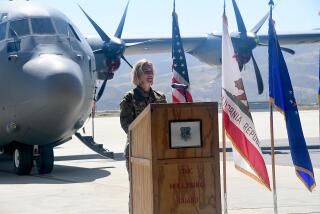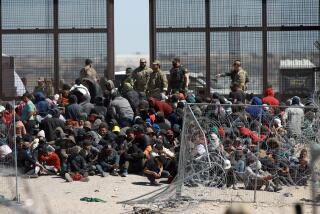Guard Might Need to Regroup for Border Duty
WASHINGTON — As the U.S. military prepared for duty along the border with Mexico, the chairman of a commission examining America’s reserve forces said Tuesday that some National Guard units would have to be reorganized to better adapt to a growing number of domestic missions.
Military tasks essential to serving in a combat zone are different than those needed for domestic security or disaster relief, said Arnold L. Punaro, chairman of the Commission on the National Guard and Reserve. Although some units can be used for both domestic security and peacekeeping missions, others ought to be focused on one task or the other, he said.
“The military likes to argue every unit can do everything. That’s baloney,” Punaro said during a meeting with defense reporters. “They will have to prioritize some units for overseas duty and some units for homeland defense.”
Punaro declined to discuss the border mission in detail, but said the assignment showed the changing role of the Guard. Domestic defense, he said, would require some reserve units to reorganize with new equipment, training and missions.
On Tuesday, administration officials provided new details of Bush’s plan to deploy 6,000 guardsmen along the border. Homeland Security Secretary Michael Chertoff said the administration hoped to begin deploying the Guard in June. Because of details to be worked out with governors, a National Guard Bureau spokeswoman could not say when the complete force would be in place.
Pentagon officials said the force of 6,000 would remain at full strength for only a year, and pledged to cut the number of Guard troops by half in the second year of the border mission.
Although guardsmen from across the country are likely to be used, the Pentagon primarily will tap soldiers from the four Southwestern border states for the mission. Most of the troops will be deployed in groups of about 100 for three-week stints, to give them time to travel to the border and have two or three days of training before they start their work, said Lt. Gen. H. Steven Blum, chief of the National Guard Bureau.
In the past, Guard units have used their annual training period to build fences on the border. The new mission, Blum said, is an expansion of the military’s long-standing counter-narcotics efforts in the border states.
“So the only thing that we’re going to be doing different is we will be doing this in a much more comprehensive and focused manner on a much grander scale,” Blum said.
Few of the jobs are likely to be combat-related. The Guard will be expected to create vehicle barriers and new roads, as well as help with transportation, surveillance, logistics and medical support.
The military is in the midst of an effort to reorganize its National Guard and Reserve forces. Congress created the commission led by Punaro to make recommendations on future missions, training and equipment as well as changes to laws and regulations governing how the Guard is used.
Punaro said he believed many Guard units should be equipped with “dual-use equipment” relevant to both overseas deployments and missions at home. And some Guard and Reserve units that have a purely military task will need to change their mission, he said.
“Some units who lived to invade North Korea are going to have to take a deep breath,” he said.
“We know from common sense we face threats [at home] we didn’t face before, and you have to make changes when you train and equip your forces,” he said. “If that means [units] have to change their missions, so be it.”
The commission began meeting in March and is due to submit a preliminary report in June. A final report will not come until next year.
Because many Guard brigades that have been deployed to Iraq must have their equipment replaced, many in the Army believe it is an important time to reassess the roles of various reserve units.
But recommendations for wholesale changes in the Guard are likely to be met with a great deal of resistance. The Guard treasures its combat role, and governors have resisted the Army’s attempts to consolidate units or shift their role from heavy forces with tanks to light infantry forces.
Some Guard veterans simply do not see the need for a wholesale reorganization. Bob Thrasher, who served as the adjutant general of the California Guard from 1987 to 1992, said missions like the border support task outlined by Bush do not call for specialized training.
“You can relate almost any skill in the military to homeland security,” he said. “But with this kind of mission they are looking for bodies, they are not looking for skills.”
The Army is currently reorganizing the Guard by eliminating artillery units and creating more military police, civil affairs units and engineers, said Col. Christine Stark, the director of law enforcement operations for the U.S. Army Peacekeeping and Stability Operations Institute in Carlisle, Pa. But the key, Stark said, was moderation.
“The balance of the force is under revision,” she said. “Will they ever go away from combat forces? Probably not. You don’t want to swing the pendulum too far one way or the other.”
*
Times staff writer Joel Havemann contributed to this report.
More to Read
Sign up for Essential California
The most important California stories and recommendations in your inbox every morning.
You may occasionally receive promotional content from the Los Angeles Times.










